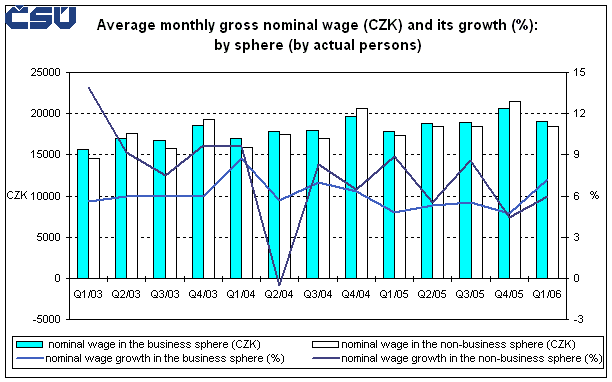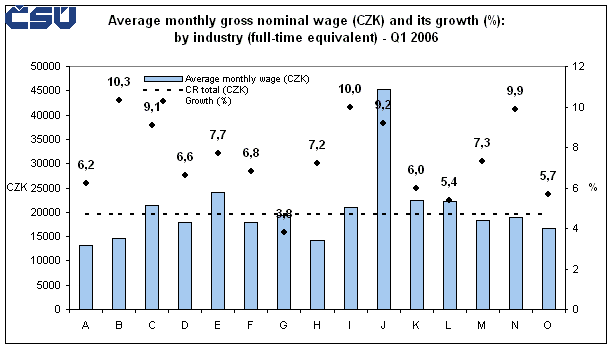Analysis of the development of average wages of employees - 1. quarter of 2006
Product Code: e-3134-06
Analysis of the development of average wages of employees 1
In Q1 2006, the average gross monthly nominal wage per actual person reached CZK 18 903 and its year-on-year increase amounted to CZK 1 222. In the business sphere the average wage increased by CZK 1 275 to CZK 19 051, while in the non-business sphere it went up by CZK 1 035 to CZK 18 390. The relative increase of the average wage was 6.9%, the growth in the business sphere being 7.2%, and in the non-business sphere 6.0%. In the same period, consumer prices went up by 2.8%, and the real wage thus rose by 4.0% in total, in the business sphere by 4.3%, and in the non-business sphere by 3.1%. From 1 January 2006, minimal wage increased by CZK 385 to CZK 7 570, which is up by 5.4% year-on-year.
From the point of view of a medium-term comparison, the relative year-on-year increment of the average wage is slightly higher than an average increment for the preceding 8 quarters. While in the Q1 2006 the increment was 6.9%, the average increment for the years 2004 and 2005 was 6.1%. As for a long-term comparison (the average annual increment for the last 5 years was 6.9%) it is an increment that is average.
Nationwide wage development is heavily shaped by the business sphere as employees of this sphere account for more than three quarters of the set of units under observation. While the wage development in the business sphere is more fluent and affected primarily by economic results of the companies, it is jump-like in nature in the non-business sphere because it depends to a large extent on legislative measures of the government and on what is permitted by the budget.
In previous years, wage differences between the business and non-business spheres usually became wider always in Q1 and Q3 of a given year - that is to say the average wage in the business sphere was higher than in the non-business one. In Q2 and Q4, the average wage levels then mostly converged, owing to half or a certain part of the additional salary regularly paid in the non-business sphere. In some periods the wage level in the non-business sphere exceeded the one in the business sphere. Nominal wage development and its relative increments by sphere are shown in the Graph 1.
In 2005, the wage development in the non-business sphere was influenced by adjustments to salaries and wages of employees in public services and administration. Apart from the normal year-on-year rise in average salaries, salaries in selected professions rose in a differentiated way. The Government Regulation No. 637/2004 Sb. “Sb.” stands for the Collection of Laws of the CR. extended the circle of employees whose wage rates are provided according to the scale of increased wage rates (e.g. employees providing social care directly, employees in charge of administrative social care services, employees engaged in work on roads, collection and processing of municipal waste, etc). Furthermore, a new scale of increased wage rates was put in place for employees – members of the Police of the CR, the Prison Service of the CR, the Fire and Rescue Service of the CR, and the Customs Administration of the CR. On 1 January 2005, the payment of the additional salaries was cancelled in the non-business sphere. The latest wage adjustment in particular helped suppress rather large differences in the wage levels between individual quarters in the non-business sphere. The wage development in this sphere therefore becomes smoother, with possible jumps caused to happen in response to legislative measures only. The first period comparable from that point of view in the non-business sphere is the Q1 2006. While in the Q1 and Q3 2005 the measure was reflected in a higher year-on-year wage increase than that, which was reported in the Q2 and Q4, from the Q1 2006 no marked fluctuations in the wage development can be expected in the sphere.
Graph 1

Given the fact that the non-business sphere employs a higher proportion of part-time workers than the business one, the following comparisons are made with average wage data related to full-time equivalent (FTE) employees as these data take account of the length of work.
In Q1 2006 the average wage per FTE person increased by CZK 1 260 year-on-year (+6.9%) to reach CZK 19 494, rising to CZK 19 491 (+7.1%, CZK +1 296) in the business sphere and CZK 19 504 (+6.2%, CZK +1 134) in the non-business sphere. The real wage increased by 4.0% in total, in the business sphere by 4.2% and by 3.3% in the non-business sphere.
Differences in the wage level and in its growth rate between industries (CZ-NACE sections) are well characterized by Graph 2. The graph suggests that the lowest wage level existed in ‘agriculture, hunting and forestry’, ‘hotels and restaurants‘, and ‘fishing‘, while the highest in ‘financial intermediation‘, ‘electricity, gas and water supply‘, and ‘real estate, renting and business activities‘. While in 2005 in two of the three CZ-NACE industries with the worst wages (‘hotels and restaurants‘ and ‘fishing‘) the wage grew the least year-on-year, in the Q1 2006 there was reported an above-average year-on-year relative increment.
Graph 2

| A | Agriculture, hunting and forestry | B | Fishing |
| C | Mining and quarrying | D | Manufacturing |
| E | Electricity, gas and water supply | F | Construction |
| G | Wholesale and retail trade; repair of motor vehicles, motorcycles and personal and household goods | H | Hotels and restaurants |
| I | Transport, storage and communications | J | Financial intermediation |
| K | Real estate; renting and business activities | L | Public administration and defence; compulsory social security |
| M | Education | N | Health and social work |
| O | Other community, social and personal service activities |
Comparisons of the wage development in the Q1 2006 in industries made at the CZ-NACE division level (two-digit code) suggested that the following three industries (employing a minimum of 20 thousand people and excluding enterprises with less than 20 employees) paid the lowest average nominal wage per FTE person:
- manufacture of wearing apparel; dressing and dyeing of fur: CZK 10 941 (the average wage in this industry was CZK 8 553 down on the national average, the nominal or relative year-on-year rise being CZK +626 or +6.1%, respectively);
- agriculture, hunting and related service activities: CZK 12 886 (CZK -6 608, CZK +718 or +5.9%);
- manufacture of textiles and textile products: CZK 13 305 (CZK -6 189, CZK +895 or +7.2%).
On the other hand, the following three industries (with the same criterion in force) were paying the highest average nominal wage per FTE person:
- financial intermediation except for insurance and pension funding: CZK 49 611 (the average wage in this industry was CZK +30 117 up on the national average, the nominal or relative year-on-year rise being CZK +4 726 or +10.5%, respectively);
- computer and related services: CZK 44 666 (the average wage in this industry was CZK 25 172 up on the national average, the nominal or relative year-on-year rise being CZK +718 or +1.6%, respectively);
- electricity, gas, steam and hot water supply: CZK 27 095 (the average wage in this industry was CZK +7 601 up on the national average, the nominal or relative year-on-year rise being CZK +2 090 or +8.4%, respectively).
The above-mentioned comparisons suggest that earnings of employees in the industry with the highest wage reached in the Q1 2006 about 4.5times the wage of employees in the industry paying the lowest wage. In the Q1 2006 inter-industry wage differences remained almost unchanged compared to the same period of 2005; the variation coefficient of average wages (by CZ-NACE division) was 0.1 percentage points up and reached 39.2% (per FTE persons).
Wholesale trade and commission trade, except of motor vehicles and motorcycles was the industry with the lowest growth or drop of real wage among industries employing at least 20 thousand people - the year-on-year drop in real wage was 1.5%. The average nominal wage in this industry increased year-on-year by 1.3%; it reached CZK 24 106 and was CZK 4 612 above the national average.
On the contrary, the industry (with the same criterion in force, i.e. employing at least 20 thousand people) with the highest achieved growth of real wage was financial intermediation, except insurance and pension funding – increase by 7.5%.
The comparison of the wage development made for sectors suggests that the highest average wages have been paid for a long time in financial institutions, insurance companies and pension funds. The Q1 2006 average wage per FTE persons in the financial institutions climbed almost up to 2.5 times as much as the national average, and the insurance companies and pension funds paid wages about 1.8 times the national average. In contrast, wages of employees in the sector of households (i.e. wages of unincorporated natural persons) do not even reach two thirds of the national average. In the sector of non-profit institutions serving households wages are about three quarters of the average wage in the whole of the CR. The average wage level, though, is fundamentally affected by the non-financial corporations sector and the government sector. Employees of these sectors make up about 95% of the set of units measured.
___________________
1 The data refer to business sphere enterprises with 20+ employees (in financial intermediation irrespective of the number of employees) and all non-business sphere organizations. They only refer to employees under employment contract with reporting units. Persons performing public office, such as members of Parliament, senators, full-time councillors at all levels, judges, etc. are excluded.
